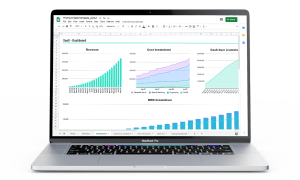
Startup Financial Model templates 6 comments

What is a Startup Financial Model?
Financial models are created to portray some of or all the aspects of a business. But for startups, financial plans are roadmaps. A startup financial model enables entrepreneurs to understand their cash and to determine their burn-rate. This is crucial for a firm, as it makes one conscious of how long money will last and what milestones can be achieved with the given expenditures.
Why do your VCs and investors need to read and understand your startup financial model?
Startup financial models are key for investors as well. They are needed to validate how much money an entrepreneur will need to start-up with, as well as how much the investor himself can potentially make on the investment. Essentially, investors are not tolerant to businesses that do not have a startup financial plan drafted and ready for analysis. Startup financial Models stem from startup business plans.
A startup business plan gives entrepreneurs some assumptions, from which they can make rational projections of costs and income for a startup financial model. Hence, different pieces can be brought together to get an overall picture of the firm (your costs, revenue, cash-flow summaries and profit & loss statements) based on a variety of assumptions.
For example, if a firm has a SaaS business model, then assumptions will differ between that of a Freemium business model. Hence, the SaaS financial model will vary greatly to that of a Freemium financial model.
Startup Business Assumptions are at the heart of your Financial Model
Although the projections do not need to be correct all times, the assumptions, however, are key. The assumptions tell whether the entrepreneur has given some thought to the startup’s potential market share, its competitors, adoption rates, etc. This is key for investors. Given the overall picture, the startup financial model enables you to depict the strengths and weaknesses of your assumptions. It pushes you to go back to your business model and revise it, in order to further develop it into a more successful instrument.
The Two types of Startup Financial models
A bottoms up startup financial model: It is one with an existing 5-15 core assumptions about the business, that is most useful for firms considering specific product direction, distribution strategy, or partnership that can potentially be a big impulse for the company.
A top down startup financial model: it one that works for a company which, for example, is aware it will need to go out and raise $X million in a Series A round in a given time frame and has gathered data on what sorts of revenue, margins, or growth numbers it needs to achieve to have a successful fundraise.
The approach to building a Startup Financial Model
Ultimately, the type of startup financial model you choose depends on what kind of firm you run. But do make sure to have the financial model in place before you incorporate your business and build your first products.
All in all, startup financial models have the additional benefit of enabling access to leverage of an accurate baseline valuation. Meaning, you can track the progress throughout your firm’s history.
You do not need to be a professional to design a Startup Financial model. To create a startup financial model for your own company, you do not need to be a finance expert. What an entrepreneur needs is the right set of tools, specially a startup financial model Excel template to get started.
The Eloquens catalogue has a variety of startup financial model Excel templates for different types of businesses, that enable you to adapt the model to one of your own. Be it a SaaS, Freemium or E-commerce business.
To customize your Startup Financial Excel Model Template to your firm, assumptions will need to be changed so specific results can be projected. Also, if you wish to add more value to your startup financial model, you may enrich it with more variables too. For example, you may add volume growth rates and number of salesmen to integrate a “What If” analyses into your model.
Also, aim to have projections in your early-stage startup financial model so that it can go up to 3 to 5 years from the present time.
If you would like more information on the subject, feel free to have a look at the following links:
-Reasons why you need a financial model by earlygrowthfinancialservices.com
-Visible.cv: Financial Modeling for Startups
Most popular templates
 Financial Model Template for any SaaS / Subscription Model Business. Including 1 Hour Walkthrough Video.2,4001add_shopping_cart$99.00
Financial Model Template for any SaaS / Subscription Model Business. Including 1 Hour Walkthrough Video.2,4001add_shopping_cart$99.00 by Remi Goncalves
by Remi Goncalves

SaaS Start Up Financial Model | Advanced Pack
SaaS Startup financial model for B2B and B2C businesses280Discussadd_shopping_cart$49.00 by Tisu Consultancy
by Tisu Consultancy

Enhanced Generic Startup Financial Projection 3 statement Excel Model
User-friendly generic model for preparing a 5-year financial projection for a startup business3,13724add_shopping_cart$39.00 by Projectify
by Projectify

Manufacturing Startup/Existing Business Financial Projection 3 Statement Model
User-friendly 3 statement 5 year rolling financial projection Excel model for existing/startup manufacturing business1,8984add_shopping_cart$59.00 by Projectify
by Projectify

Network/Marketplace Startup 5-Year Financial Model with Cap Table
Plan out the assumptions for a startup marketplace or network and see what the 5-year forecast looks like. 3 statement model included.2,616Discussadd_shopping_cart$45.00 by Jason Varner
by Jason Varner

Generic Startup Financial Projection 3 statement Excel Model
User-friendly model for preparing a financial projection for a startup business10,0106add_shopping_cart$35.00 by Projectify
by Projectify








